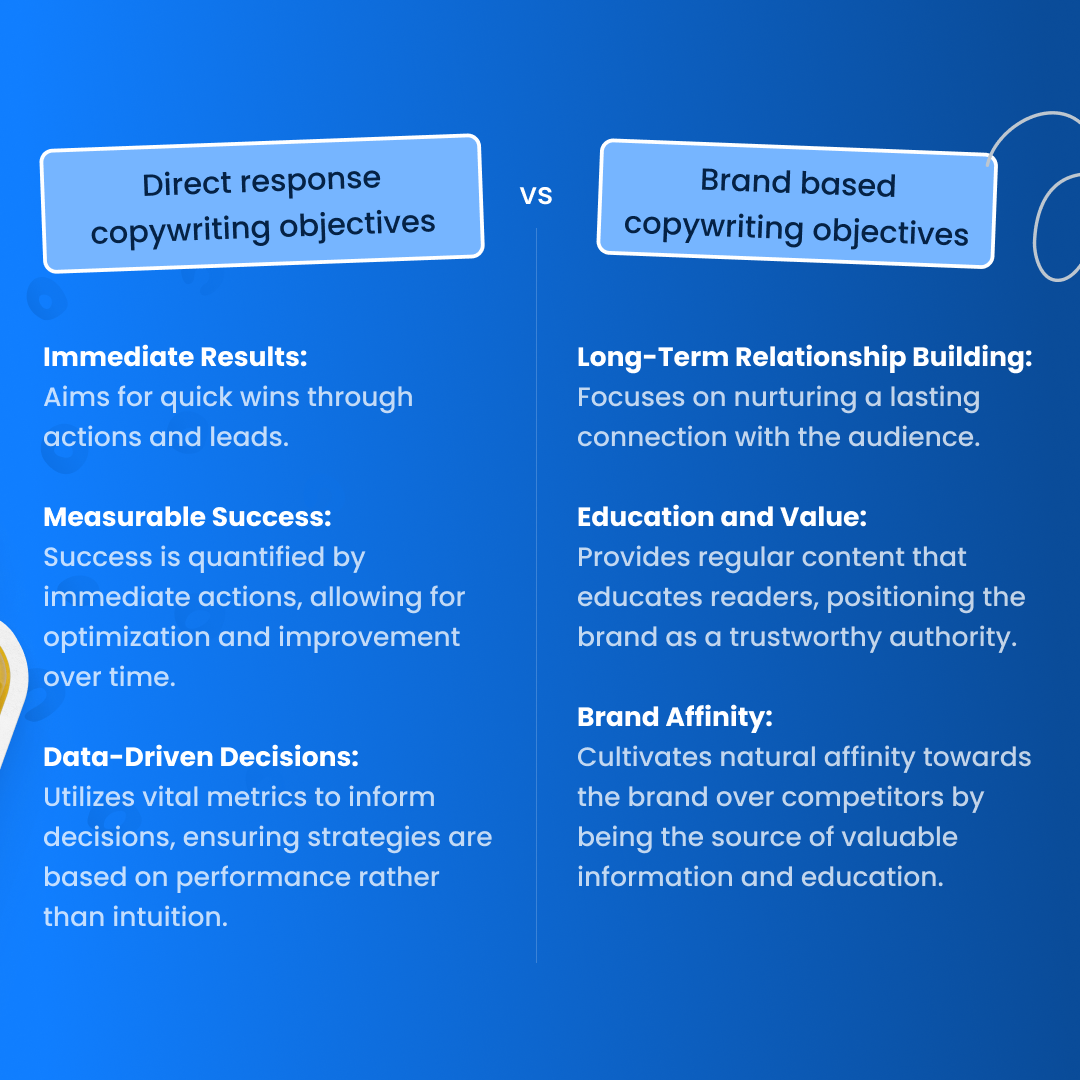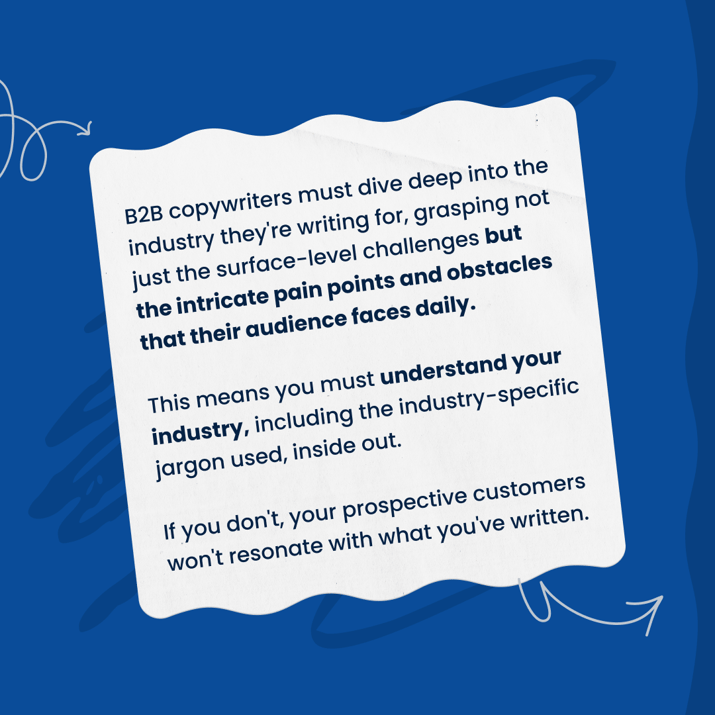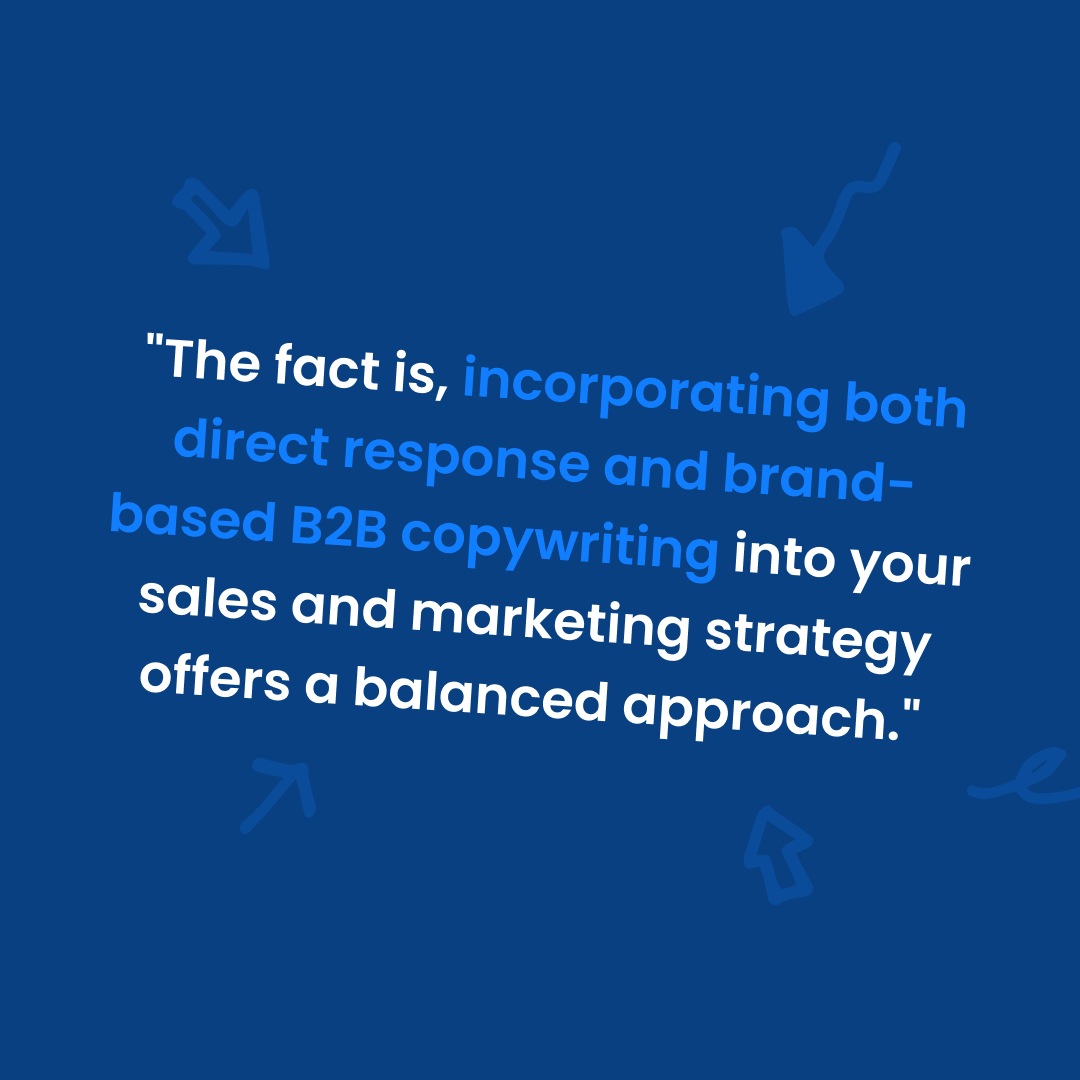Business to business (B2B) copywriting plays a pivotal role in bridging the gap between technological innovation and customer engagement.

When it comes to writing copy that encourages your ideal target audience to take action, it’s not just about crafting messages.
Instead, it's about using customer and industry insights to weave a narrative that resonates with your target audience, turning complex solutions into compelling stories.
As a HubSpot partner agency, we understand the nuances of copywriting, from landing pages designed to convert to email sequences that nurture leads into customers.
And now we want to share our knowledge with you to help you generate awareness for your business, attract leads, and send better qualified potential buyers across to your sales team.
In this blog, we're going to unravel the layers of B2B copywriting , showcasing how a blend of strategic messaging and deep industry insight can drive growth, engage existing customers, and attract potential B2B clients and customers.
Understanding B2B Copywriting

B2B copywriting stands as a specialized form of writing, tailored to meet the needs of businesses seeking to engage with other businesses.
This type of copywriting is significantly different from Business-to-Consumer (B2C) copywriting in its approach, tone, and the complexity of the content.
The distinction lies primarily in the audience and the nature of the decision-making process.
Let us explain:
In B2B transactions, the purchases are often significant, involving considerable amounts of money and requiring approval from multiple levels within an organization.
This creates a scenario where the sales cycles are notably longer, and the content needs to cater to a series of more detailed and technical considerations.
In this realm, understanding the target audience is crucial.
B2B copywriters must dive deep into the industry they're writing for, grasping not just the surface-level challenges but the intricate pain points and obstacles that their audience faces daily.
This means you must understand your industry, including the industry-specific jargon used, inside out.
If you don't, your prospective customers won't resonate with what you've written.
Period.
Yet when you do speak the same "language" (i.e. the phrases used) as your ideal audience, you'll be able to speak directly to them.
More than that, once you know what their pain points are like the back of your hand, you'll grab your reader's attention and keep it, which will almost certainly boost conversions.
B2B Copywriting Challenges
The challenges in B2B copywriting are unique due to the informational depth and educational content required.
Prospective clients are often looking for evidence of thought leadership and a demonstration of in-depth knowledge about their particular challenges.
Therefore, B2B copywriters (whether freelance or in-house) frequently find themselves producing not just promotional material but a range of content types, from white papers and case studies to in-depth articles and guides.
This variety underscores the need for versatility and adaptability in writing style and content strategy.
Now, this can put a high demand on whoever is writing your copy.
After all, writing sales copy for a landing page is different to a blog post where you're trying to "game" the search engines...
And that in turn is very different to writing social media advertisements in a specific brand voice, which again is entirely different to writing highly technical white papers.
The point is, there's a vast array of copy to be written.
That means opportunities within B2B copywriting are expansive.
The Major B2B Copywriting Opportunities
It's kind of stating the obvious, but the digital transformation over the past couple of decades has led to an increased demand for high-quality, engaging content that can cut through the noise and deliver value.
B2B companies are in constant need of compelling content that supports their sales processes, builds brand authority, and educates their prospective clients.
As such, the role of a B2B copywriter (or whoever is writing your copy in your organization) is not just to sell but to inform, educate, and build trust over time, establishing a foundation for long-term business relationships.
Successful B2B copywriting hinges on the ability to translate complex ideas into clear, engaging, and persuasive content.
It's about making a business case, substantiating claims with data points, and presenting solutions in a way that aligns with the strategic goals of the target audience.
This involves a balancing act between being informative and being persuasive, requiring a nuanced understanding of how businesses evaluate potential solutions and make purchase decisions.
The Evolution of B2B Copywriting
The evolution of B2B copywriting is ongoing, with new platforms and mediums constantly emerging.
This dynamic landscape offers you the chance to explore innovative formats and strategies, from interactive digital content to personalized email campaigns.
Staying ahead in this field means staying informed about the latest industry trends, technological advancements, and content marketing strategies, all while maintaining a laser focus on the needs and behaviors of the target audience.
To sum up, B2B copywriting is a critical component of modern business strategy, demanding a skill set that combines:
- Industry knowledge to keep your reader interested and your potential customers engaged
- Marketing acumen to ensure you create content that doesn't just engage, but also generates leads. (In some cases, for lower-price deals, your copywriting skills will even help you sell directly on the page, meaning you can leave your sales teams to focus exclusively on the bigger deals.)
- Writing prowess to put your message across in an engaging way that holds the attention of a business audience, no matter if it's C Level Executives or people further down the "food chain."
Ultimately, the challenges B2B copywriting presents, from navigating complex sales cycles to addressing sophisticated business needs, are matched by the opportunities it offers for creative and strategic content marketing.
As businesses continue to seek out ways to effectively reach and engage business leaders or other decision makers, B2B copywriting is only going to become more and more important, making it a vital skill for you to master if you want to attract new customers like clockwork.
Sales Copy VS Brand Voice Copy
Navigating the broad landscape of B2B copywriting can feel like trekking through uncharted territory for many marketers.
Yet understanding its varied terrain is crucial for crafting messages that resonate with your business audience.
At its core, B2B copywriting unfolds across two main spectrums: Direct response (which is essentially sales copy - the kind used in a sales funnel) and brand-based copywriting.
Each plays a distinct role in a comprehensive B2B marketing strategy, catering to different objectives and stages of the customer journey.
Let's talk about direct response copywriting first.
It's the adrenaline rush of the copywriting universe, designed to provoke an immediate reaction or action from the reader.
Think of it as the marketing equivalent of a call to arms, urging your audience to take a specific step without delay.
Whether it's signing up for a webinar, downloading a white paper, or making a purchase, direct response copywriting zeroes in on achieving immediate results.
The essence of direct response lies in its measurability.
You can directly correlate specific words to actions taken, providing a clear view of what works and what doesn't.
This form of copywriting is about creating a compelling argument for why the reader should act now.
It taps into the reader's emotions, logic, and sense of urgency, often through persuasive headlines, bullet points, and clear calls-to-action (CTAs).
When writing direct response sales and marketing copy, you also want to use lots of social proof to overcome a person's natural skepticism.
On the other hand, brand-based copywriting is the marathon runner in the B2B marketing race.
It's not about the quick sprint to immediate conversion but about building endurance and establishing deep, enduring relationships with your audience. Brand-based copywriting nurtures brand recognition, trust, and loyalty over time, aiming to position a company as the go-to authority or thought leader in its field.
This form of B2B copywriting is all about getting the brand's values, mission, and unique selling propositions across.
It's often a vital part of a company's content marketing strategy, because it's less about prompting immediate action and more about cultivating a consistent brand image across all platforms.
Brand-based copywriting is the foundation for storytelling that connects emotionally with your audience, making your brand memorable and relatable.
Direct Response B2B Copywriting Examples
For direct response, consider a targeted email campaign designed to encourage sign-ups for an exclusive industry report.
The copy is direct, leveraging statistics, testimonials, and a time-sensitive offer to create a sense of urgency.
The email is crafted to guide the reader swiftly towards clicking the "Download Now" button, making the pathway to action clear and compelling.
Brand-Based B2B Copywriting Examples
A brand-based copywriting example might be a series of blog posts that explore industry challenges, innovations, and insights.
These posts are meticulously crafted to reflect the brand's expertise and values, where the primary goal is to build a sense of trust and reliability among readers.
The hope would be that, over time, readers come to associate the brand with thought leadership and high-quality information.
So even though it doesn't drive immediate sales and isn't focused on conversion rates, it does result in a loyal audience likely to choose the brand when they're ready to buy, even if that's a couple of years in the future.
What Are The Objectives of Direct Response and Brand-Based Copywriting?
Direct response aims for quick wins.
You measure success in immediate actions taken and leads generated.
Its strength lies in its ability to be quantified and optimized for better performance over time.
Companies that are able to measure vital metrics will have an advantage over ones that don't, because they'll know if a piece of sales or marketing copy is actually working or not.
It means they won't stop using something just because they "feel like changing it".
On the flip side, it also means they won't persist with a piece of copy (such as a landing page) if it's not generating a positive return on investment (ROI).
In contrast, brand-based copywriting is about the long-term.
Sure, success is harder to measure in the short term.
But think about it:
Regular content creation (a great form of brand-based copywriting and marketing) gives you the chance to educate readers.
And if your company is the one doing the teaching, they're going to feel a natural affinity towards you...
NOT your competitors.
But here's the thing...
It's NOT About Choosing One Form Or The Other...

The fact is, incorporating both direct response and brand-based B2B copywriting into your sales and marketing strategy offers a balanced approach.
By understanding the unique advantages and applications of each, marketers can create more nuanced and effective B2B copy that not only converts but also builds a strong, enduring brand presence.
Remember, the key to successful B2B copywriting lies in knowing your audience deeply.
This knowledge enables you to craft messages that resonate, whether you're aiming for immediate action or long-term engagement.
It's about speaking directly to the needs, challenges, and aspirations of your business audience, using the right form of copywriting to meet them where they are in their journey.
So, whether you're drafting an email designed to get clicks or crafting a blog post that tells your brand's story, the spectrum of B2B copywriting offers a diverse toolkit for connecting with your audience.
By mastering the art and science of both direct response and brand-based copywriting, you can ensure that your marketing efforts not only capture attention but also cultivate lasting relationships with your business clients.
Summing Up The Benefits Of Mastering B2B Copywriting
Mastering the craft of B2B copywriting is crucial if you want to generate a higher quantity and Quality of leads.
Yet many businesses don't put anywhere near enough focus on becoming good at it.
But after reading this, their loss is now your gain.
Listen:
Great copywriting requires a deep understanding of the dual landscapes of direct response and brand-based copywriting, each serving unique purposes in engaging with a professional audience.
But you don't have to be a great writer in order to write amazing B2B copy.
If you know your ideal customer inside out, including their pains and dreams, their frustrations and desires, then finding the right words to use on sales pages, a landing page, a social media ad, or even a white paper becomes easy.
The Last Word on B2B Copywriting
In this blog post, we've highlighted the significance of direct response and brand based copywriting in driving immediate actions and building long-term relationships, respectively.
The value of specialized B2B copywriting in achieving marketing and sales goals cannot be overstated, as it bridges the gap between businesses and their potential clients with precision and empathy.
Though even if you think you know enough about copywritin to write great short form content, landing pages, or any other types of sales or marking content, know this:
The landscape of professional communication is constantly shifting.
So you need to keep up to date with new trends emerging and audience preferences changing.
To remain effective and relevant, you must adapt, continuously refining your approach to language, format, and engagement strategies.
In conclusion, let this blog post serve as a stepping stone on your path to becoming a more proficient and impactful B2B communicator.
The insights and examples we talked about are but a glimpse of the potential that specialized B2B copywriting holds in achieving remarkable marketing and sales outcomes.
%20Leads.png)


